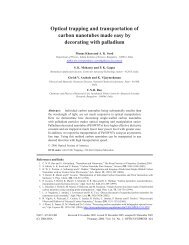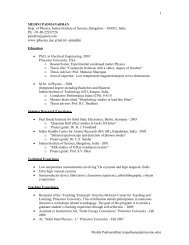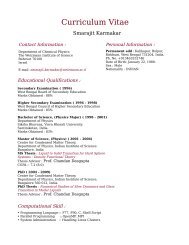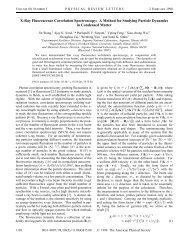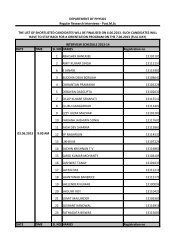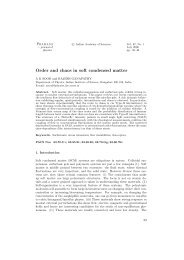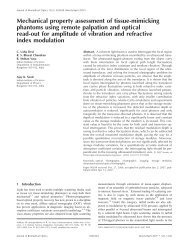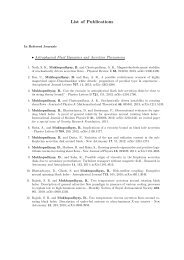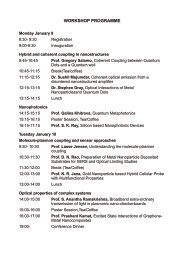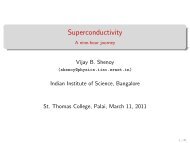Hydrodynamic Fluctuations and Instabilities in Ordered ... - Physics
Hydrodynamic Fluctuations and Instabilities in Ordered ... - Physics
Hydrodynamic Fluctuations and Instabilities in Ordered ... - Physics
Create successful ePaper yourself
Turn your PDF publications into a flip-book with our unique Google optimized e-Paper software.
VOLUME 89, NUMBER 5 PHYSICAL REVIEW LETTERS 29JULY 2002<br />
r<br />
p<br />
f p r;t<br />
f X ^n t f r r t a ^n t<br />
r r t a 0 ^n t g : (2)<br />
The apolar <strong>and</strong> polar SPPs we mentioned early <strong>in</strong> this<br />
Letter correspond, respectively, to a a 0 <strong>and</strong> a a 0 .<br />
Exp<strong>and</strong><strong>in</strong>g the delta functions <strong>in</strong> (2) about r gives<br />
f p<br />
i ’ a a0 X<br />
fr<br />
2 j ^n i ^n j r r O rr : (3)<br />
In a coarse-gra<strong>in</strong>ed description this clearly leads to a shear<br />
stress<br />
p a a 0<br />
1<br />
ij r;t fc r;t n<br />
2<br />
i n j<br />
3 ij O r (4)<br />
as claimed above. Note that only the sum a a 0 appears <strong>in</strong><br />
(4); to lead<strong>in</strong>g order <strong>in</strong> gradients, the self-propell<strong>in</strong>g stress<br />
is the same for polar <strong>and</strong> apolar phases. Us<strong>in</strong>g this stress <strong>in</strong><br />
the momentum equation @ t g i r j ij , Fourier transform<strong>in</strong>g<br />
<strong>in</strong> space, replac<strong>in</strong>g g by the hydrodynamic velocity<br />
field u g= , <strong>and</strong> project<strong>in</strong>g transverse to the wave<br />
vector q to impose <strong>in</strong>compressibility (r u 0 yields,<br />
after some algebra,<br />
@u ?<br />
@t<br />
iw 0 q z I 2 q ?q ?<br />
q 2 n ? i q2 z<br />
q 2 q ? c ...<br />
(5)<br />
where I is the unit tensor, <strong>and</strong> fa= <strong>and</strong> w 0 c 0 are<br />
phenomenological constants proportional to the activity of<br />
the SPPs. In (5), nematic-elastic torques [14] <strong>and</strong> viscous<br />
forces, both of which are subdom<strong>in</strong>ant at small q, have<br />
been ignored, as have <strong>in</strong>ertial <strong>and</strong> other nonl<strong>in</strong>earities. The<br />
pressurelike term despite transverse projection <strong>and</strong> the<br />
acceleration proportional to the bend q z n ? arise purely<br />
because of self-propulsion [18].<br />
Number conservation of SPPs implies @ t c r j,<br />
where the current j cv 0 ^n apart from advection by fluid<br />
flow <strong>and</strong> diffusion. To lowest order <strong>in</strong> gradients <strong>and</strong> fields,<br />
this tells us that<br />
@ t v 0 @ z c c 0 v 0 r ? n ? (6)<br />
which says the concentration changes by advection by the<br />
mean drift v 0 or by local splay (s<strong>in</strong>ce that implies a<br />
divergence <strong>in</strong> the local SPP velocity).<br />
We can now extract the propagat<strong>in</strong>g waves <strong>and</strong> <strong>in</strong>stabilities<br />
mentioned at the start of this paper, from the<br />
dispersion relation, frequency ! as a function of wave<br />
vector q, for modes vary<strong>in</strong>g as exp iq r i!t , implied<br />
by Eqs. (1), (5), <strong>and</strong> (6).<br />
Bend-twist waves: Tak<strong>in</strong>g the curl of (1) <strong>and</strong> (5) yields<br />
the coupled dynamics of bend or twist (r n ? ) <strong>and</strong><br />
vorticity (r u ? ). Fourier transform<strong>in</strong>g <strong>in</strong> space <strong>and</strong><br />
time yields ! c bt q, with wave speeds (see Fig. 1)<br />
c bt c 1 c 2 cos ; (7)<br />
where is the angle between the propagation vector <strong>and</strong><br />
the order<strong>in</strong>g direction, <strong>and</strong> c 1 <strong>and</strong> c 2 (of order the drift<br />
speed v 0 of the SPPs) are phenomenological constants.<br />
An analysis ignor<strong>in</strong>g hydrodynamic flow, as <strong>in</strong> [6,8,9],<br />
would <strong>in</strong>stead predict purely diffusive relaxation for bend<br />
<strong>and</strong> twist.<br />
Splay-concentration <strong>and</strong> drift waves: Tak<strong>in</strong>g the divergence<br />
of (1) <strong>and</strong> (5) results <strong>in</strong> coupled equations of motion<br />
for r n ? , r u ? , <strong>and</strong> c. The result<strong>in</strong>g wavelike eigenmodes<br />
are a generalization of those seen <strong>in</strong> [9]. Their<br />
speeds obey a messy cubic equation which, we can show<br />
[20], has real solutions for a f<strong>in</strong>ite range of parameter<br />
values. The speeds as functions of direction, for typical<br />
parameter values, are illustrated <strong>in</strong> Fig. 2.<br />
Viscous effects, <strong>and</strong> the <strong>in</strong>stability of polar SPP suspensions<br />
<strong>in</strong> the Stokesian limit: So far, we have ignored<br />
damp<strong>in</strong>g terms <strong>in</strong> the equations of motion s<strong>in</strong>ce they<br />
enter at next-to-lead<strong>in</strong>g order <strong>in</strong> wave number q. There<br />
are three types of such terms: (i) viscous damp<strong>in</strong>g q 2 u<br />
<strong>in</strong> the momentum equation (where is a typical k<strong>in</strong>ematic<br />
viscosity of the suspension); (ii) Dq 2 c <strong>in</strong> the concentration<br />
equation, D be<strong>in</strong>g a diffusivity; (iii) D n q 2 n ? <strong>in</strong> the<br />
director equation where D n is a director diffusivity which<br />
we expect to be comparable to D. In bacteria, diffusivities<br />
are of order 10 6 cm 2 =s [3] <strong>and</strong> can clearly be neglected<br />
relative to the viscosity. In large-Re systems such as fish,<br />
we have no reliable estimate of D, but it seems reasonable<br />
to assume it is no larger than . Accord<strong>in</strong>gly, when damp<strong>in</strong>g<br />
terms are <strong>in</strong>cluded, the modes will rema<strong>in</strong> propagat<strong>in</strong>g<br />
only for qa



